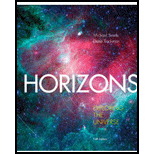
What is the largest dimension of which you have personal knowledge? Have you run a mile? Hiked 10 miles? Run a marathon?
To tell about the largest dimension that we have personal knowledge. We need to tell about a mile,hiked 10 miles and run a marathon when we run a distance.
Answer to Problem 1RQ
The largest dimension based on personal knowledge is mile or kilometer. A normal person can easily run a mile in routine. For hike 10 miles, small practice is required but for run the marathon, regular practice is required based on gradual increase in the miles.
Explanation of Solution
The largest dimension based on personal knowledge is mile or kilometer because in a normal routine a person may walk or run 3 to 4 miles. There is another fact that the next dimension after kilometer is megameter which is 1000 times of kilometer (approximately is equal to the radius of the Earth). To run a megameter is impossible for any person at personal level in the World.
Yes, we (as a normal person) have run a mile in our routine. This is essential because a mile is equal to 1.6 kilometer (approximately) but when we hike this distance by 10 miles then it will not be so easy for a normal person. I have run 10 miles only once.
Normally, marathon run lies between 26 miles to 30 miles. I have never run a marathon because for this run, a regular practice is required. To achieve the target of marathon, we should start the run-practice from 5 miles and should increase the distance gradually on weekly basis.
Hence, we conclude that the largest dimension based on personal knowledge is mile or kilometer. A normal person can easily run a mile in routine. For hike 10 miles, small practice is required but for run the marathon, regular practice is required based on gradual increase in the miles.
Conclusion:
The largest dimension based on personal knowledge is mile or kilometer. A normal person can easily run a mile in routine. For hike 10 miles, small practice is required but for run the marathon, regular practice is required based on gradual increase in the miles.
Want to see more full solutions like this?
Chapter 1 Solutions
Horizons: Exploring the Universe - With MindTap
- Please solve this problem correctly please and be sure to provide explanation on each step so I can understand what's been done thank you. (preferrably type out everything)arrow_forwardUse a calculation to determine how far the fishing boat is from the water level .Determine distance Yarrow_forwardNo chatgpt pls will upvote Already got wrong chatgpt answerarrow_forward
- 2. 1. Tube Rating Charts Name: Directions: For the given information state if the technique is safe or unsafe and why. 60 Hertz Stator Operation Effective Focal Spot Size- 0.6 mm Peak Kilovolts MA 2 150 140 130 120 110 100 90 80 70 2501 60 50 40 30 .01 .02 .04.06 .1 .2 .4.6 1 8 10 Maximum Exposure Time In Seconds Is an exposure of 80 kVp, 0.1 second and 200 mA within the limits of the single phase, 0.6 mm focal spot tube rating chart above? Is an exposure of 100 kVp, 0.9 second and 150 mA within the limits of the single phase, 0.6 mm focal spot tube rating chart above?arrow_forwardQ: You have a CO2 laser resonator (λ = 10.6 μm). It has two curved mirrors with R₁=10m, R2= 8m, and mirror separation /= 5m. Find: R2-10 m tl Z-O 12 R1-8 m 1. Confocal parameter. b= 21w2/2 =√1 (R1-1)(R2-1)(R1+R2-21)/R1+R2-21) 2. Beam waist at t₁ & t2- 3. Waist radius (wo). 4. 5. The radius of the laser beam outside the resonator and about 0.5m from R₂- Divergence angle. 6. Radius of curvature for phase front on the mirrors R₁ & R2-arrow_forwardNo chatgpt pls will upvotearrow_forward
 Foundations of Astronomy (MindTap Course List)PhysicsISBN:9781337399920Author:Michael A. Seeds, Dana BackmanPublisher:Cengage Learning
Foundations of Astronomy (MindTap Course List)PhysicsISBN:9781337399920Author:Michael A. Seeds, Dana BackmanPublisher:Cengage Learning Stars and Galaxies (MindTap Course List)PhysicsISBN:9781337399944Author:Michael A. SeedsPublisher:Cengage Learning
Stars and Galaxies (MindTap Course List)PhysicsISBN:9781337399944Author:Michael A. SeedsPublisher:Cengage Learning

 AstronomyPhysicsISBN:9781938168284Author:Andrew Fraknoi; David Morrison; Sidney C. WolffPublisher:OpenStax
AstronomyPhysicsISBN:9781938168284Author:Andrew Fraknoi; David Morrison; Sidney C. WolffPublisher:OpenStax Stars and GalaxiesPhysicsISBN:9781305120785Author:Michael A. Seeds, Dana BackmanPublisher:Cengage Learning
Stars and GalaxiesPhysicsISBN:9781305120785Author:Michael A. Seeds, Dana BackmanPublisher:Cengage Learning





